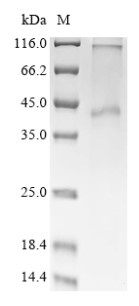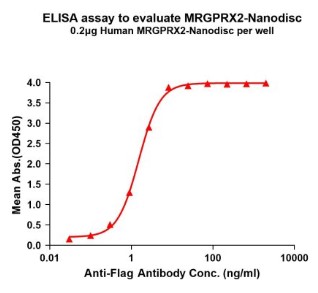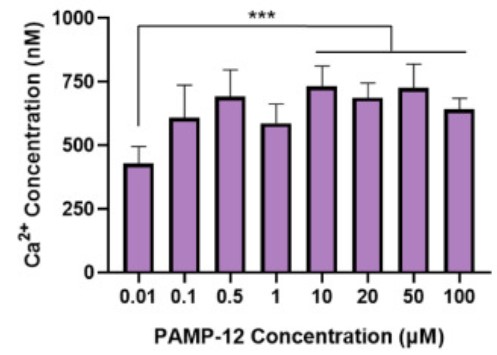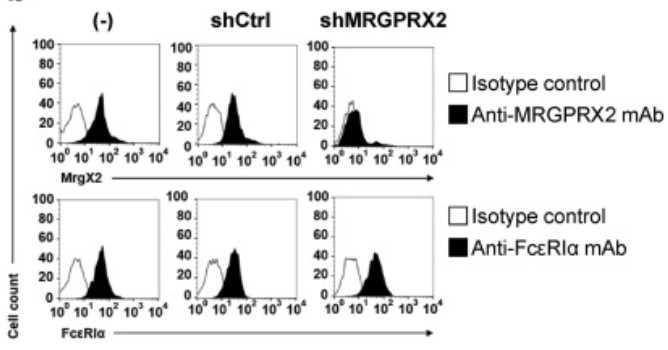MRGPRX2
-
Official Full Name
MAS-related GPR, member X2
-
Overview
Mas-related G-protein coupled receptor member X2 is a protein that in humans is encoded by the MRGPRX2 gene. -
Synonyms
MRGPRX2; MAS-related GPR, member X2; mas-related G-protein coupled receptor member X2; MRGX2; G protein-coupled receptor MRGX2;
- Recombinant Proteins
- Cell & Tissue Lysates
- Protein Pre-coupled Magnetic Beads
- Assay Kits
- Gorilla gorilla gorilla (Western lowland gorilla)
- Homo sapiens (Human)
- Hoolock hoolock (Western hoolock gibbon) (Bunopithecus hoolock)
- Human
- Macaca fascicularis (Crab-eating macaque) (Cynomolgus monkey)
- Macaca mulatta (Rhesus macaque)
- Mus musculus (Mouse)
- Pan troglodytes (Chimpanzee)
- Pongo pygmaeus (Bornean orangutan)
- Rhesus Macaque
- Rhinopithecus bieti (Black snub-nosed monkey) (Pygathrix bieti)
- Trachypithecus francoisi (Francois' leaf monkey) (Presbytis francoisi)
- E.coli
- E.coli expression system
- HEK293
- In Vitro Cell Free System
- In vitro E. coli expression system
- Mammalian Cell
- Wheat Germ
- GST
- His
- His (Fc)
- Avi
- N/A
- Background
- Quality Guarantee
- Case Study
- Involved Pathway
- Protein Function
- Interacting Protein
What is MRGPRX2 protein?
MRGPRX2 stands for Mas-related GPR family member X2. It is a G protein-coupled receptor (GPCR) protein that is expressed highly in sensory neurons in the dorsal root ganglia and trigeminal ganglia.
It belongs to the MRG (Mas-related G protein-coupled) receptor family which detects pruritogens (itch-causing substances). MRGPRX2 acts as a receptor for pruritogens such as chloroquine, histamine, BAM8-22 peptide, etc. Its activation leads to itch sensation. When activated by ligands, MRGPRX2 couples to Gα14 subunit of G protein and activates downstream signaling pathways like PLCβ-IP3/DAG pathway. This ultimately leads to depolarization of sensory neurons. Genetic ablation or inhibition of MRGPRX2 reduces itch responses induced by various pruritogens, suggesting its crucial role in itch transmission. It is expressed in nearly all neurons of the dorsal root ganglia that respond to itch. So it functions as a key receptor for detection and transmission of itch sensory signals from the skin to the central nervous system. Dysregulation or mutations in MRGPRX2 have been linked to chronic itch/pruritus conditions like atopic dermatitis and cholestatic pruritus.
MRGPRX2 is an important GPCR that acts as the main receptor for detection and transmission of itch sensation mediated by various pruritogens through peripheral sensory neurons. Understanding its function and regulation is valuable for developing anti-itch therapies.
What is the function of MRGPRX2 protein?
MRGPRX2 functions as a key receptor located on the peripheral terminals of pruriceptors to sense pruritogens and trigger intracellular signaling that leads to itch perception via the nervous system.The main function of MRGPRX2 is to act as a receptor for pruritogens on sensory neurons and mediate the detection and transmission of itch signals from the periphery to the CNS. This makes it central to the itch sensation pathway.
MRGPRX2 related signaling pathway
MRGPRX2 couples to Gα14 to activate PLCβ/IP3 and DAG pathways, resulting in increase in intracellular Ca2+ and PKC activation. This modulates ion channels and generates action potentials to transmit pruritic signals to the CNS.
MRGPRX2 Related Diseases
- Atopic dermatitis (eczema): Mice deficient in Mrgprx2 show reduced itch induced by atopic dermatitis-like skin lesions. It suggests a role in atopic dermatitis-related chronic itch.
- Chronic cholestatic pruritus: Itch is a common symptom of cholestasis. Patients with elevated bile acids show increased MRGPRX2 expression. Bile acids may activate MRGPRX2 to induce itch.
- Histamine-dependent itch: MRGPRX2 is crucial for histamine-induced itch. Mice lacking Mrgprx2 are resistant to acute itch from intravenous histamine.
- Chronic idiopathic pruritus: Polymorphisms in the MRGPRX2 gene were found to correlate with chronic idiopathic pruritus in Chinese population.
- Drug target for anti-itch medications: Inhibiting MRGPRX2 activity/signaling could provide relief from itch in various dermatological and systemic diseases involving chronic itch. Many antagonists are under research.
- Biomarker for diagnosing itchy conditions: Monitoring temporal changes in MRGPRX2 expression levels in skin/blood could aid diagnosis of diseases presenting with pruritus like eczema, liver disorders etc.
- Screening new anti-pruritic drugs: High-throughput screening using assays measuring MRGPRX2 activation/signaling can help identify novel therapeutic molecules to target chronic itch.
Biomedical Application of MRGPRX2 Protein
- Drug target for anti-itch medications: Inhibiting MRGPRX2 activity/signaling could provide relief from itch in various dermatological and systemic diseases involving chronic itch. Many antagonists are under research.
- Gene therapy approach: Over-expressing anti-itch microRNAs or delivering therapeutic genes locally that suppress MRGPRX2 levels may alleviate persistent itch conditions.
- Itch pathway dissection: Using mouse models with Mrgprx2 knockout or overexpression helps elucidate ligand-receptor interactions and complex neuronal pathways behind itch sensation.
- Itch pathway dissection: Using mouse models with Mrgprx2 knockout or overexpression helps elucidate ligand-receptor interactions and complex neuronal pathways behind itch sensation.
- Screening new anti-pruritic drugs: High-throughput screening using assays measuring MRGPRX2 activation/signaling can help identify novel therapeutic molecules to target chronic itch.
High Purity

Fig1. SDS-PAGE (MRGPRX2-1043H)
High Bioactivity & Detection Sensitivity

Fig2. Elisa plates were pre-coated with Flag Tag MRGPRX2-Nanodisc (0.2μg/per well). Serial diluted anti-Flag monoclonal antibody solutions were added, washed, and incubated with secondary antibody before Elisa reading. From above data, the EC50 for anti-Flag monoclonal antibody binding with MRGPRX2-Nanodisc is 1.523ng/ml.

(Lei Lu, 2021)
Fig3. Specificity of PAMP-12 towards MRGPRX2 receptor. (a) dose dependent calcium release from HEK-X2 with increasing PAMP-12 concentration

(Nobuyuki Nishimori, 2021)
Fig4. HK-1–induced histamine release from synovium–derived and skin–derived cultured MCs through MRGPRX2. (b) Cell surface expression of MRGPRX2 on non–transduced (−), non-targeted shRNA–transduced (shCtrl) and MRGPRX2 shRNA–transduced synovium–derived cultured MCs (shMRGPRX2). The black–filled histograms indicate MCs treated with anti-MRGPRX2 mAb (upper panels) or anti-FcεRI mAb (lower panels). The open histograms indicate isotype Ig–treated MCs. Representative data from 3 experiments using 2 different donors' MCs.
MRGPRX2 involved in several pathways and played different roles in them. We selected most pathways MRGPRX2 participated on our site, such as , which may be useful for your reference. Also, other proteins which involved in the same pathway with MRGPRX2 were listed below. Creative BioMart supplied nearly all the proteins listed, you can search them on our site.
| Pathway Name | Pathway Related Protein |
|---|
MRGPRX2 has several biochemical functions, for example, G-protein coupled receptor activity, mast cell secretagogue receptor activity, neuropeptide binding. Some of the functions are cooperated with other proteins, some of the functions could acted by MRGPRX2 itself. We selected most functions MRGPRX2 had, and list some proteins which have the same functions with MRGPRX2. You can find most of the proteins on our site.
| Function | Related Protein |
|---|---|
| G-protein coupled receptor activity | VALOPB;EXORH;GPR113;OR8A1;GPR34L;ACKR3B;MRGPRX2;OLFR480;GPR31 |
| mast cell secretagogue receptor activity | |
| neuropeptide binding | SSTR2;ADCYAP1R1;MRGPRX2;NPBWR2;SSTR4;NPY8BR;GPR149;GPR1;OPRM1 |
MRGPRX2 has direct interactions with proteins and molecules. Those interactions were detected by several methods such as yeast two hybrid, co-IP, pull-down and so on. We selected proteins and molecules interacted with MRGPRX2 here. Most of them are supplied by our site. Hope this information will be useful for your research of MRGPRX2.
- Q&As
- Reviews
Q&As (5)
Ask a questionMRGPRX2 activation on mast cells can lead to the release of histamine and other pro-inflammatory substances, contributing to allergic reactions.
Some experimental drugs targeting MRGPRX2 are under investigation for their potential in treating allergic and inflammatory conditions.
There is emerging research exploring the role of MRGPRX2 in pain modulation, making it a potential target for pain management strategies.
Research suggests that modulating MRGPRX2 activity could be a potential therapeutic strategy for managing allergic conditions.
Dysregulation of MRGPRX2 has been implicated in conditions such as chronic urticaria and certain inflammatory disorders.
Customer Reviews (3)
Write a reviewBeyond its superb performance in Western blotting, the MRGPRX2 protein has also proven invaluable in protein electron microscopy structure analysis.
Its versatility and reliability make it an excellent choice for researchers seeking to delve deeper into the mechanisms and functions of the MRGPRX2 protein.
the MRGPRX2 protein comes highly recommended for its exceptional performance in Western blot analysis and its utility in protein electron microscopy structure analysis.
Ask a Question for All MRGPRX2 Products
Required fields are marked with *
My Review for All MRGPRX2 Products
Required fields are marked with *


